Bang! comes from Bitplay and is a lamp like any other at a first glance. When the user no longer needs light, he or she can simply take the “white weapon”, point it at the lamp and shoot. A second gun trigger will have the reverse effect.

Can architects and designers *really* design in Procreate, or is it just a glorified digital sketchbook? In today's tutorial for architects, designers and students, I demonstrate the "super powers" of Procreate that make it the ideal choice to imagine your design, develop it in scale, then hand it off for further development in Rhino or Sketchup. What makes Procreate such a powerful design tool is that it combines the best of both worlds…
Good things really do happen when you expect them the least.
For years I’ve been on the lookout for good ways to explain the advantages of designing and rendering by hand with Procreate, versus traditional designing and rendering by hand with pencil on paper. I haven't found the exact right words yet, but I keep looking.
Then this morning I woke up and saw on Twitter that the cartoonist Gary Larson was starting to cartoon again. He retired from drawing "The Dark Side" about 10 years ago, but according to this announcement he was starting to draw again-- for fun. Not the deadline-based, cartooning with which he entertained the world for 15 years, but drawing for his own amusement. Naturally my interest was peeked! But then it got better.
In today's masterclass, I show you how quick gestures with Procreate brushes can be all you need to create compelling concept design renderings full of life and energy
In today's masterclass, I show you how designing with sketches can give your ideas the time and attention they need to grow, bringing your client into the creative process, as opposed to shutting them out with the false promise of half-baked photorealistic concept designs.
Bang! comes from Bitplay and is a lamp like any other at a first glance. When the user no longer needs light, he or she can simply take the “white weapon”, point it at the lamp and shoot. A second gun trigger will have the reverse effect.

In Part One below, we saw the beginning of an architectural idea: stackable, pre-fab units that come together in a way that animates building and neighborhood. The series of images below follows the thread of that design through to the final black-and-white digital renderings.
Bitt, you may be asking yourself why an architect who does traditional pencil and watercolor architectural rendering would present final images of his own design in a black-and-white digital style-especially given that architect's thoughts on the shortcomings of digital rendering. In this case we were looking for a dispassionate style which combined the strengths of digital modeling (real-time navigation as we pitched the project to the Planning Board) with the charms of the pencil sketch.
Anyone else find ways to combine digital rendering and traditional rendering tools to save time and money in the architectural rendering process? Stew? Chip? Dale? Mark? Tom? Bill? Vic? Leave your comments, lads. As always, click on images to enjoy detail.
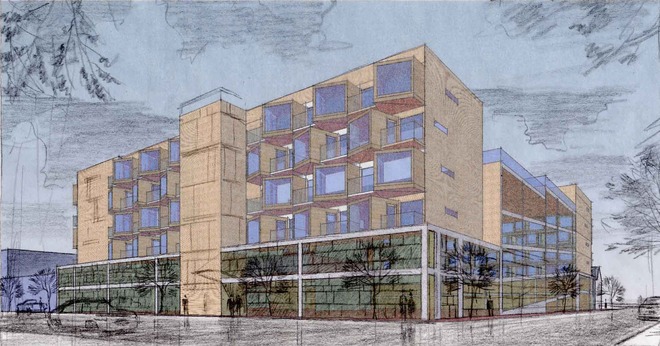
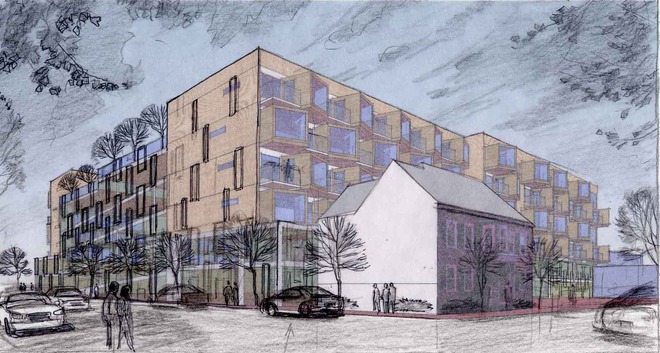
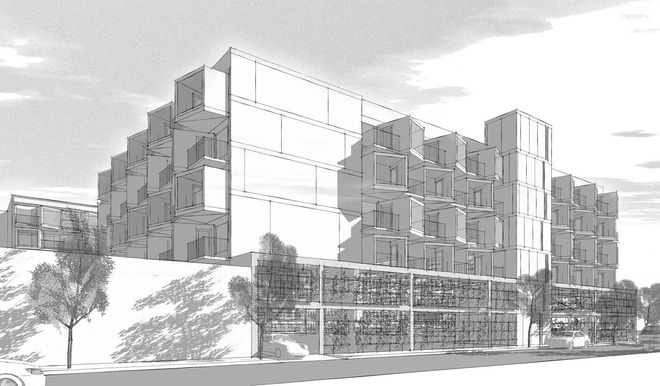
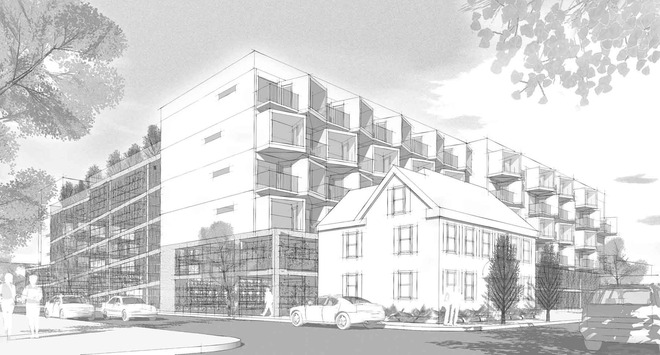
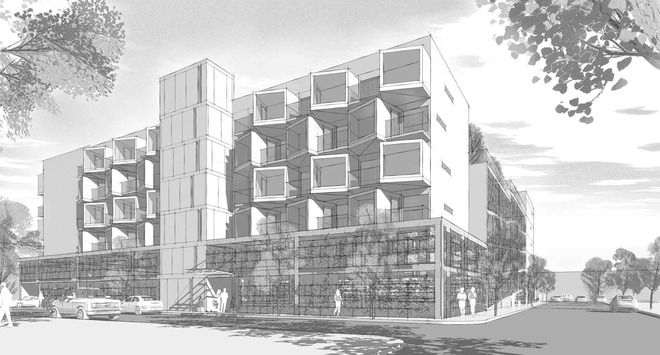
Alan C. is a developer and very smart guy. Why? (OK, I'm biased.) Because he called me out of the blue in 2005 and said something to the effect of "Hey, I have this site and I want to study the as-of-right possibilities. I see from your site you are also a registered architect. If I show you plans and sections of a building I have in mind, will you design the exterior, make the presentation drawings and help me pitch the concept to the powers that be?"
As it happens, I had had something similar in mind for a long time. Why not approach developers directly explaining that as an architect with a gift for presentation, I could help them study their options (not claiming to offer final services, mind you) more quickly and efficiently than engaging a "high profile" architect who--given the exigencies of running a large practice--would just assign the exercise to a couple of talented in-house designers anyway, slowing the whole thing down and making it cost 2 to 5 times my fee?
So I said yes, and we began the collaboration pictured below. We used a combination of traditional and digital architectural rendering techniques to explore directions, culminating in the simple black-and-white digital renderings at the end. I'm going to leave out the commentary and just make this a visual journey for now, but suffice it to say that the economic meltdown of 2008 froze the banking system and took down the project. Unless something has happened, I am confident Alan C. and his gorgeous wife S. are passing the time cooking, drinking red wine, dabbling with a little spleef from time to time, and listening to a whole lot of Bob Dylan. He's gonna rise again, trust me.
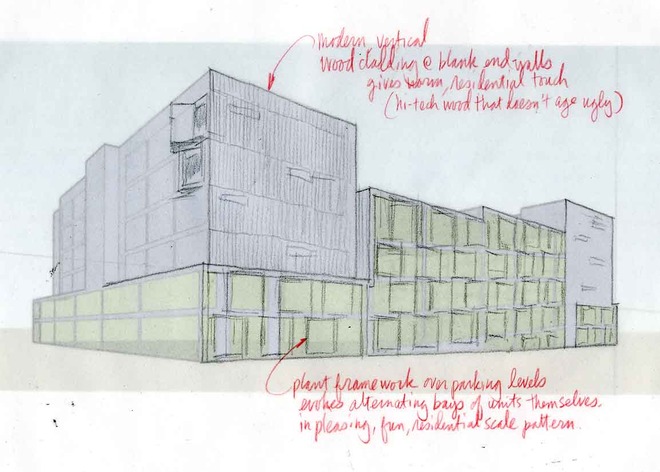
Early study based on SketchUp massing study (below)
Idea of pre-fab, stackable units enters in:

Note that project sits on top of parking...always a challenge:
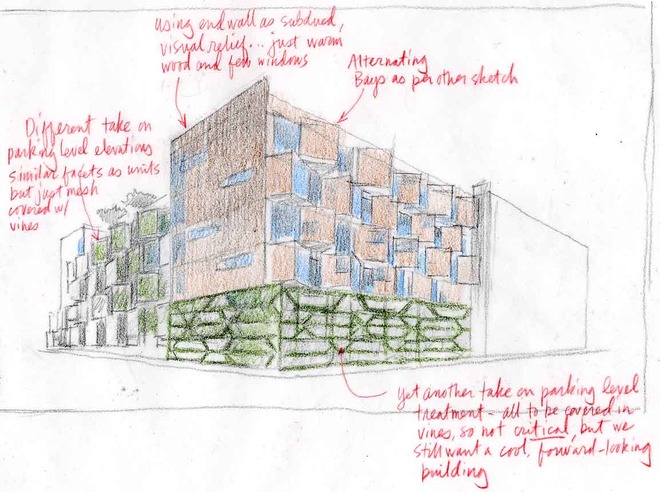
Detour into another idea...
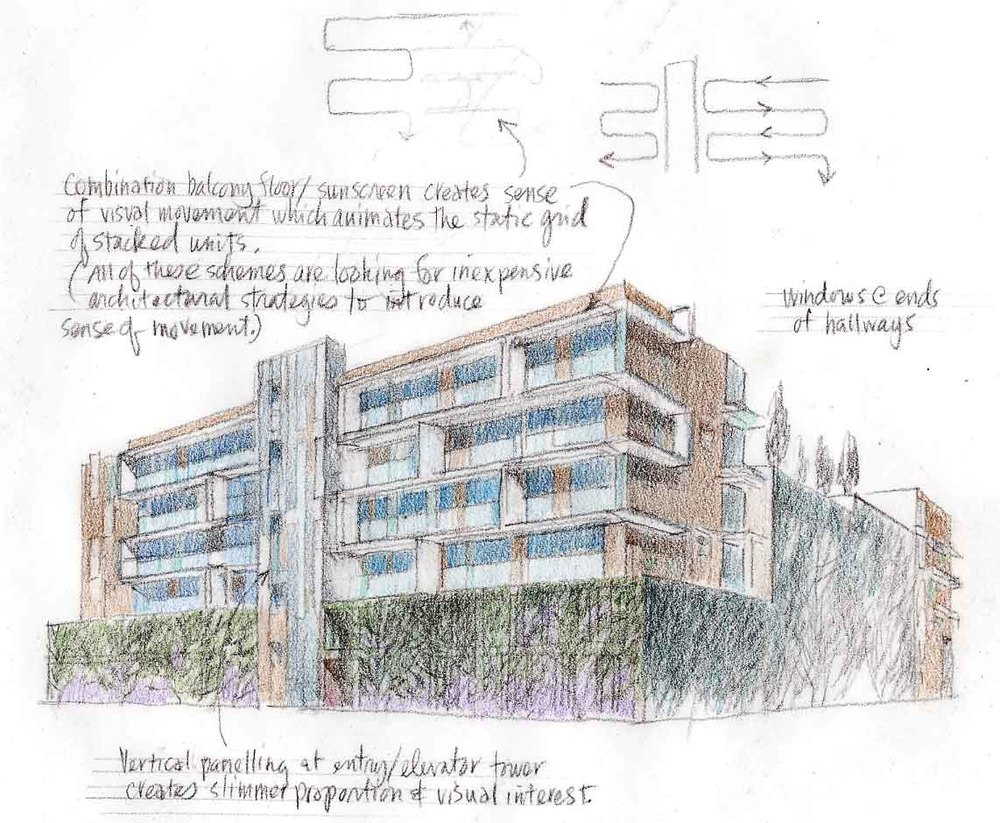
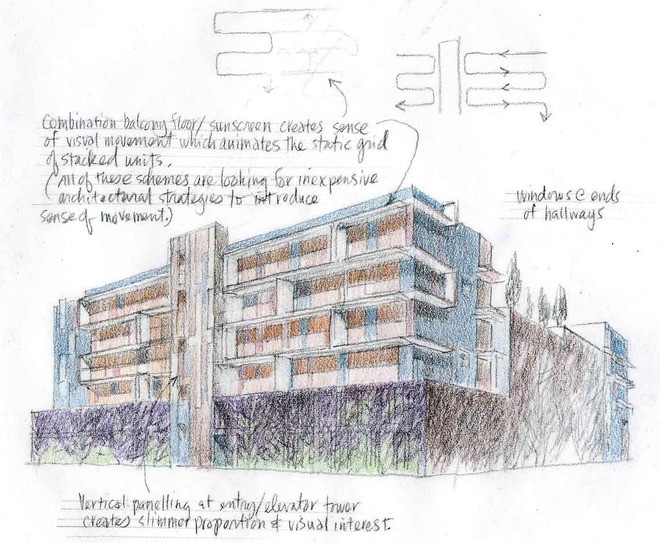
Back to a funkier rhythm:
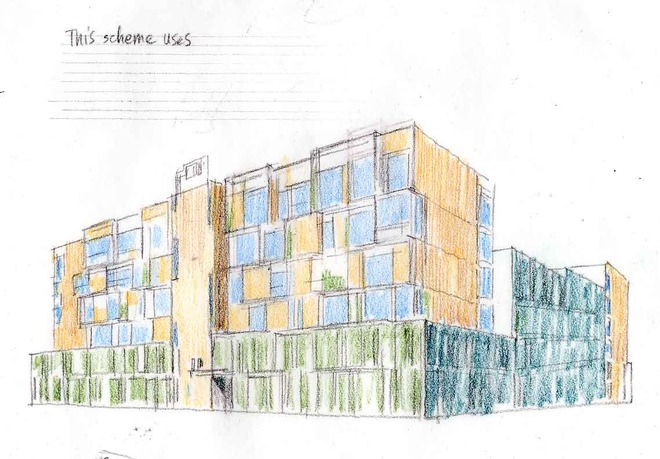
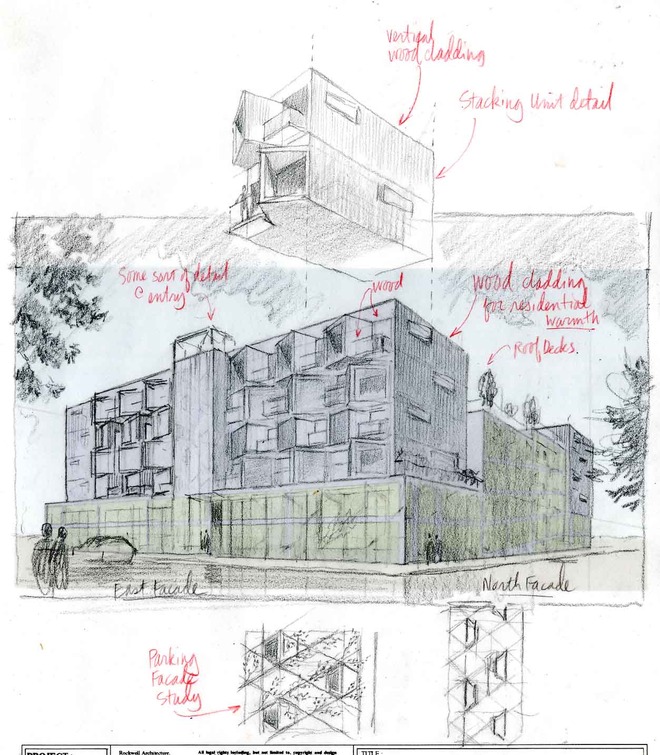
See Part 2 above.
"So it seems Keith Olbermann was unimpressed, which is a very good sign.
I've been trying to think of why yesterday was unlike almost any other rally I've ever been to.
One obvious observation: it was the first actual ironic rally I've attended. Most of those in this movement were clearly ambivalent about being in any movement, but at the same time seemed to be acting out of some shared civic duty. "One man can write a pun, but every man must try." Almost every poster and placard was ironic, or undercut the ego or seriousness of the protester. One of my truly in-joke favorites: "Personally, I Blame Matt Yglesias." Who cannot rally behind that?
There were very, very few explicitly partisan appeals or personal attacks on public figures; and if the Beck rally coalesced around vague themes of patriotism, God and motherhood, this one seemed motivated by a simple sensibility of reason, empiricism and humor. But it was no less determined for that, in a quiet, midwestern, Frances-McDormand-In-Fargo kind of way. It was BobBo, but also Generation Obama; it was cool, but also unfashionable in a frumpy NPR-listener kind of way. It was the post-everything American middle class.
The point, it seemed to me, was that politics isn't all there is to life, there is something slightly off about those who think it is, and that political ideology has come to define us culturally and personally far too much. So this wasn't an angry rally for the alienated Democratic left; or even a joyous rally like last fall's March for Equality; or a desperate and frustrated rally like the Tea Partiers. No one was demanding their country back; they were just demanding, well asking, for a little less polarization, and a little more mutual understanding. It was an Obama rally that didn't want to be an Obama rally. And it was only an Obama rally sotto voce because he seems currently the only adult in Washington with any interest in compromising with anyone.
There are, after all, three political groupings in American politics Republicans, Democrats and Independents. But there are also three cultural groupings: ideologues, the pragmatists, and the totally indifferent. This was a rally for the pragmatists, which made it, for my money, the core Obama base.
It wasn't ethnically very diverse, but there were many more boomers than I expected. It was very good humored, and one sensed that the entire crowd loathed Fox, felt queasy about MSNBC, couldn't bring themselves to watch CNN and caught NPR in the commute. The young were out in force, but, again, they seemed like the Obama generation - not the facile dreamers who saw a Messiah in 2008, but the resilient rump who knew full well what he was up against.
Is this actually a politics?
Not if one compares it with, say the Perotistas of the early 1990s, or the Beckians of August (almost all of whom will surely be voting Republican on Tuesday because to do otherwise is the end of all American liberty for ever). But it is an identity politics: proud of being educated, sick of being stereotyped, interested in facts and reality, fed up with being condescended to ... and deeeply worried about the direction in this country.
If the ghost of Richard Nixon will allow me, Stewart and Colbert have sensed a silent plurality, alienated by both parties, still hoping for Obama's success, and yet unwilling to worship any politician or even take themselves too seriously for fear of falling into the same foul-smelling bullshit that already covers far too much of our political culture.
And that gave me not just a great afternoon. It gave me hope."
I love the process part of making an architectural rendering in watercolor. (See more examples here.) Frankly it isn't that different from the process of making a digital rendering. It's still--and always will be--about emotion and storytelling. Great right brain stuff (or is it left brain?). But the process itself satisfies the opposite problem-solving part of the brain as well: how do I save my client the most time and money while producing the maximum emotional effect? Sometimes it starts with something as basic as photos taped together and scanned.
This project for Hampton College--one of a series of renderings for a proposed master plan--shows a sensitive scheme by Shepley Bullfinch for the renovation of an existing "background building" along Main Street. As always, click on images to make them (much) bigger.
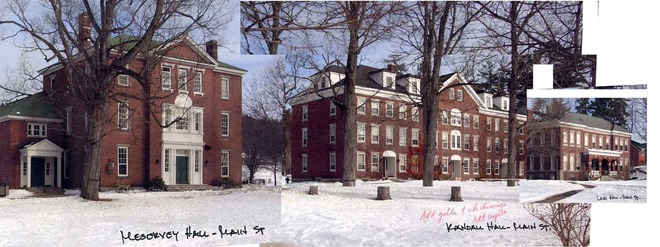
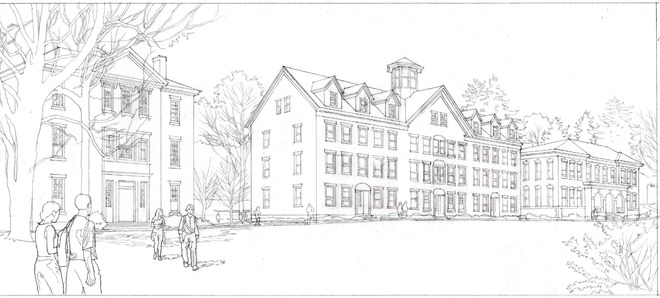
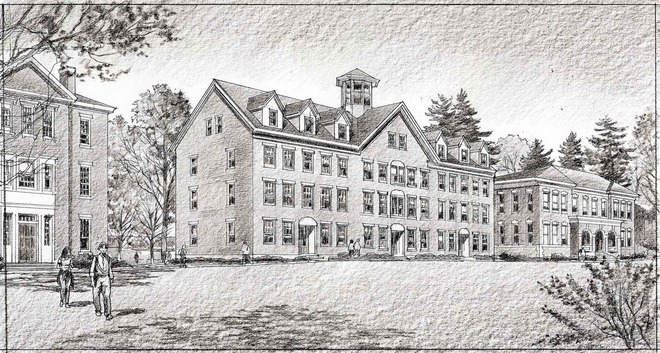
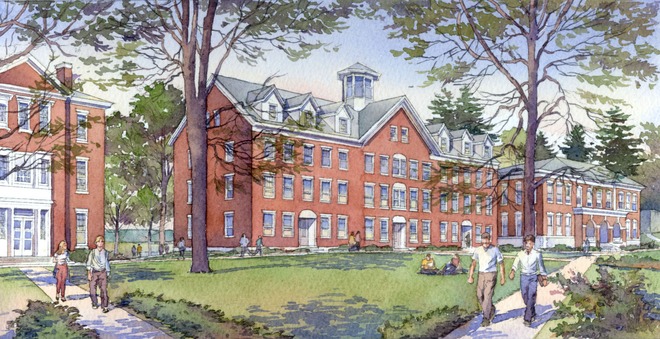
Enjoy more images like this in the Process section of this website.
 The ultimate method of personalizing a bicycle. Designer and Swiss art director Juri Zaech considers this type of “tuning” truly unique. Even though this product is not that related to architectural rendering by hand it strikes me as original and worth sharing.
The ultimate method of personalizing a bicycle. Designer and Swiss art director Juri Zaech considers this type of “tuning” truly unique. Even though this product is not that related to architectural rendering by hand it strikes me as original and worth sharing.
When Ark Restaurants, interior designer Nancy Mah and lighting designer Brian Orter needed a change to an existing rendering of Bryant Park Restaurant to reflect a new lighting design, the answer was to modify the rendering of this cultural landmark to show more of the entrance from Bryant Park. Here is the process we used. Click on any image to enlarge.
Original rendering:
Quick photoshop study of proposed patch:
Notes from the client:
Context photos:
Pencil line drawing of patch:
Watercolored patch added to original in photoshop:
Overhead festoon lighting and additional floor lanterns added in photoshop:
Final version with festoon lights raised.
That was fun, wasn't it? According to the designers, the revised rendering was a hit with the Bryant Park commission.
Appendix: Here are some keywords which will help readers index this article:
(Note: Many of you were kind enough to ask for a copy of the text. As proud father I have added a few pictures to the text:)
Good afternoon class of 2010, families, and faculty. I have mixed feelings about thanking Mrs. Young for informing me that I would be speaking today. But I do want to thank her along with all of the parents, siblings, teachers, counselors and administrators for putting up with this unforgettable class of 2010. Closer to home, I’d like to thank my dad; my brother for writing this speech; my grandmother for all of the dating tips, and; my mom for the more than 2,000 lunches she’s made me over the years. (I really appreciated that change up from turkey to pesto junior year, Mom.) Finally, thank you to the class of 2010, I couldn’t ask for a better group of students to be representing today, Monument’s gonna miss us!
(L to R: Simon McTeigue, Lili Michaels, Jacob Rolf, Natalie Akers, Claire Smith, Brian Hutchison)
The other day I was watching home videos, and I noticed two patterns in the behavior of my brothers and I, which I think are universal. First, we loved being naked and we weren’t self-conscious about it. And second, we loved to laugh and smile. Watching the utter bliss on my little brother’s face made me question where it all went? Why does the happiness of children come so easily, and why do we have to work so hard at it now? It’s one of life’s great ironies that we wait until we are seventy-four to rewind back to four. We forget how simple it was to be happy as a toddler, and in all of the commotion of trying to learn, that light seems to dim or even burn out.
Monument has provided me with some of my most important experiences to date. After all, I have seen a streaker at a football game, a slip n’ slide set up in the back hall, an epic food fight in the cafeteria, and now I even have a tattoo on my ankle because I lost a bet with Mrs. Baldwin. (You’ll have to ask Mrs. Baldwin where hers is.) In all seriousness, our teachers, coaches, and counselors have taught us how to discover and probe and question and analyze. Yet, the joy a first grader feels executing their first crooked and struggling upper case “A” is now often drowned out by the bell to change classes. It is still there if we remember. We just have to un-learn a little to learn. There is a similar paradox about happiness that I have tried to embrace over my last few years here: the idea that we must sometimes be still in order to move forward.
When my older brother passed away my freshman year, I did NOT come to some grand realization about how to live my life. Instead, I became freaked out at how randomly our lives move and unfold. I started to fear the reality that anyone can leave at any time, and I wondered whether achieving high honor roll for 8 semesters would actually count more in the end than laughing hysterically with my friends, burning marshmallows around a campfire. I suddenly felt that fifteen years of my life were an accumulation of nothing “real,” and I became frantic to get real things done, fast. Yet, after I took more onto my plate and tried to tackle more than I could take down, I found my new “accomplishments” to be no more “real” or satisfying than the things I did before my brother’s death. I should have been moving out of desire to taste and experience new things. Instead, I was moving forward like the overly- serious kid who plays Mario cart. The kid that races to pick up all the gold tokens but forgets to laugh with friends after he slides out on his own banana peel. I was doing a lot, but I wasn’t doing any of it very deeply. In an attempt to “live every day,” I had actually stopped savoring each individual day. I needed to slow down and learn to be “still.” As Albert Camus wrote, “you will never be happy if you continue to search for what happiness consists of. You will never live if you are looking for the meaning of life.”
Our class will continue to move forward fast in the world as athletes, academics, business men and women, mechanics, musicians, engineers, artists, or whatever each one of us chooses. As a class, we have been eager and curious and we have never had trouble finding things to do and doing them well. Yet there is a downside to this kind of movement for movement’s sake. It’s unsustainable, and that simple happiness in the moment that comes to us so easily as a child can be slowly extinguished by the dissatisfaction that makes us jump from one thing to the next. It’s not greed, it’s just the need for motion and its natural. In fact, its how we get stuff done. We press and push forward and even sometimes backwards. But, we forget that real moments are often what lie between the commotion---in what one might call the pockets of stillness.
It is hard to explain this stillness, and it is even harder to maintain it. I’m not talking about watching “minute to win it” with a bag of pita chips on the couch (which by the way I recommend everyone do at least once). I can share one experience I had when I recently went hiking with my PEOPLE IN THE ENVIRONMENT class. The last night of our camping trip, Woody and Dakota asked me if I wanted to sprint up to the top of the mountain to try and see the sunset with them. We STRUGGLED, but once we reached the summit we were able to look out across three states. We watched the sky change from color to color and then we stood on the edge of the rocks and yelled our names into the wind. I felt five years old again, but without the urge to be naked. I didn’t feel ridiculous and I couldn’t stop smiling. My fear in the overwhelming randomness of our day-to-day lives came back to me, but in the form of confidence. As the three of us sat there saying nothing, just staring off at that horizon, it was hard not to think how small we all are. ***It was as if the more insignificant I felt, the more liberated and powerful I became. Maybe by submitting to this feeling of powerlessness, we gain the courage to be still and small and calm and THAT in turn, empowers us to listen and act and live. ****
Over the last few years, I have tried to keep in mind that time can either be seen as a series of obligations and unfulfilled wishes, or as pockets of stillness. When we learn this, we can fill our lives with whatever we love most: whether that is the natural world, athletics, family, friends, or Mario Cart. When you try to be still and live in the moment, that is the best kind of movement. It’s comforting to know that it’s really that simple.
Thanks for listening and good luck CLASS OF 2010!!!
Spencer James Akers
Well, readers, this marks the introduction of the start up mobile and web app that a team of us have been working on for the last year. BuyLOca is 100% intended for the use and benefit of the LOCAL independent businesses who... well, wait, I'll just copy in the press release. Enjoy, and be sure to check out the wireframe diagrams at the end of how the mobile and web app will work.
Press Release, May 21, 2010
from BALLE conference in Charleston, SC
Introducing buyLOca (in beta)...
A Shopper-driven Solution For Sustainable Local Ecommerce
BuyLOca is the mobile (iPhone) and web app that allows shoppers to make photo-based wish lists--tagged with price, location and store name--then share them with friends and family via email and over social networks (because who couldn't use a little help with the 50 gifts--from birthdays to graduations to holidays to housewarming parties that families of four feel "obligated" to exchange every year. Make that 25 for couples without kids.)
BuyLOca is, of course, meant to be a huge convenience for shoppers, but it's also designed to do something VERY cool for local independent merchants and service providers. The magic occurs when buyLOca aggregates shoppers' wish list photos to both users' homepages, and to FREE "wiki" store pages for the local businesses from where items are listed (since 90% of these businesses lack the resources to build their own ecommerce capability and can use the help in competing with malls, big box stores and online retailers!). Bottom line? As shoppers share their wish lists via email and social network: 1) THEY get what they really want from friends and family on gift giving occasions; 2) BUSINESS OWNERS get free ecommerce pages (built spontaneously from their customers' wishes, which turns out to be an efficient and powerful form of online search recommendation engine) and viral word of mouth advertising over customers' social networks, and; 3) the NETWORK EFFECTS create a virtuous cycle and drive even MORE TRAFFIC TO LOCAL BUSINESSES and BUY LOCAL PROGRAMS .
Additionally, as growing numbers of store owners add items and services to their free pages, local goods and services in general become more visible to ORGANIC SEARCH (where according to Forrester Research, an astonishing 90% of all discretionary shopping begins these days), allowing random online shoppers to find the goods they're searching for LOCALLY before they reflexively venture off to malls, big box stores and online retailers. The fact that wish listers and their favorite stores will tend to be in the same area means that buyLOca will also save last minute gift buyers (i.e. all of us) the growing expense of 1-,2- or even 5-day shipping typical of last minute online purchases.
In summary, buyLOca helps--at the scale of the individual online and offline shopper--to make the connections between producers and consumers that the best Buy Local networks seek to make, and SHIFTS a portion of day-to-day shopping--starting with gift buying--back to the local businesses that form the heart and soul of our local communities (and--in striking contrast to the policies of national chains--the supporters of our local Little League teams and High School Musicals:).
Although buyLOca begins as an app that makes gift giving easier, more accurate and more meaningful, its MISSION is to revolutionize local ecommerce and help sustain local economies by: 1) cataloging and uploading local goods and services "one wish list at a time;" 2) encouraging local businesses to upload more of their local goods and services to their free pages, and; 3) laying the foundation for a mobile and web channel that allows a million-plus resource-challenged local businesses to extend the geographic and seasonal markets for their goods and services to a global online and mobile audience.
BuyLOca is looking for communities that would like to help us beta test the service, and for angel investors who would like to be a part of the team working toward a 2010 holiday season launch. Please call Jamie Akers at 413-250-8800 if you wish to help with either. Thank you for your time, and remember, we are in beta, so we invite you to help us make buyLOca better with your suggestions in the comments section.
The following diagrams--though one generation old--give the general idea for how the mobile and web app will work.
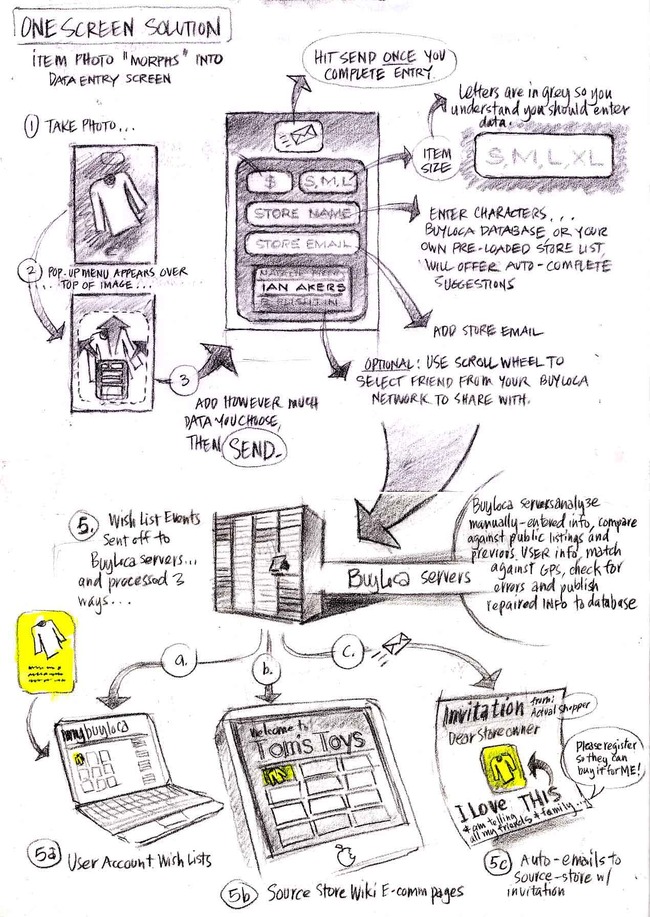

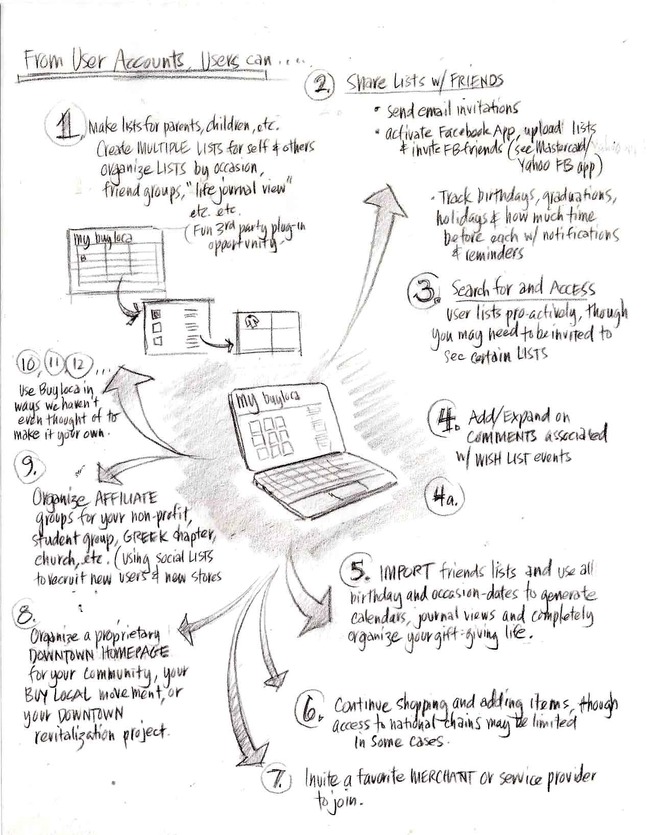
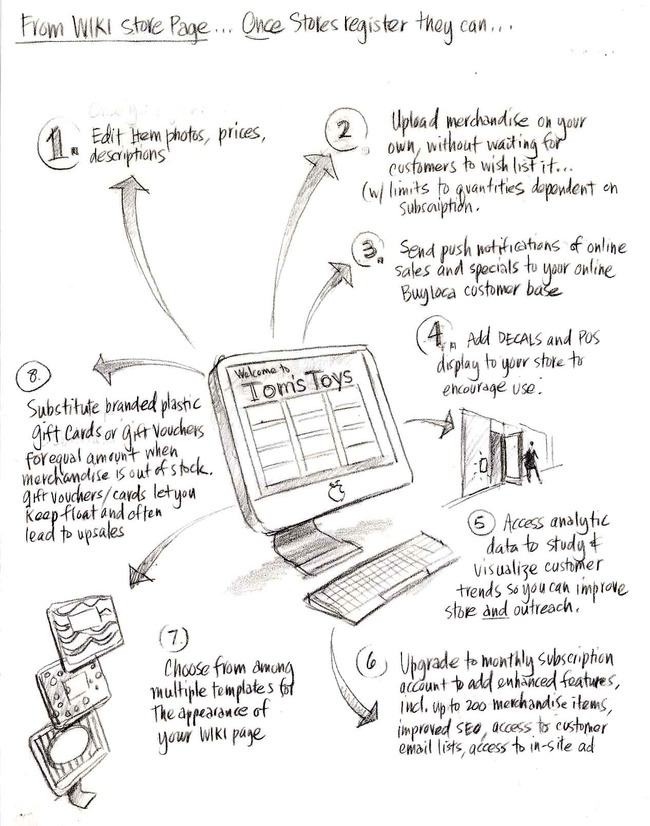

(Note to new readers: Although I'm a registered architect who does architectural renderings and 3D digital renderings, I am currently starting up a mobile and web-based business as a means of a) staying sane, b) remaining sanguine about the bleak economic outlook for architecture as we know it, and c) reconnecting with the entrepreneurial passion that made me want to be an architect in the first place. This series is an effort to share what I'm learning with others using their "time off from employment" to reconnect with their passions and start up a business.
PART TWO: WHAT IS "GOOGLE READER" AND WHY YOU SHOULD USE IT
Here's the table of contents from last post. We're on Chapter 4 today, but don't forget to read post one if you missed it:
Coming Chapters Overview:
Google Reader is the best research tool I've found. "Regular" Google searches result in reams of pages that--more and more--seem biased by spamming and commercial interests, requiring hours of tedious DSL-speed page opening and closing to sort through. Reader, on the other hand, allows you to focus your search by first identifying the authoritative voices blogging on subjects relevant to your start up idea, then aggregating feeds from those blogs into a personal, automatically assembled and self-renewing stream of information which you scroll through in your Reader window. My research became 500%-1,000% more efficient the day I dscovered Reader. Of course Reader was only meaningful because of first discovering who I should be following, and I did that via the various podcasts I was listening to as described in my last post.
The basics are as follows:
Reader adds the blog to the column on the left of your new Reader page, and later allows you to organize your blogs by subject folder. When you highlight a single blog or folder, only the contents of that stream appear in the Reader field, allowing you to scroll through the information from all--or just related--blogs in a single rolling feed. This allows you to go right to your most-read daily items (Andrew Sullivan for me) as often (or in my case, compulsively) as you want, and save work related research for work times. The efficiency and time savings from NOT having to bounce around between different blog sites in your browser is reason alone to adopt Reader, but Reader goes way beyond that.
For example, you can subscribe to all the blogs that a list of noted authorities and/or celebrities subscribe to. (Seriously, it's very cool.) Or you can browse blogs by subject matter as pre-organized by Google. And Reader lets you store articles of interest in a number of ways, including posting them to your own blog with a single click (btw, Google's free blog tool is called Blogger and that's worth a chapter) starring them, sharing them as part of your own RSS feed, or emailing them, and you can do all of that from within the stream (vs. taking all the time to open up the original source page then doing it). Just go and get lost in it for an hour or two and you'll quickly appreciate the efficiencies it brings, not to mention the amazing new factoid you discovered about QR codes or Paypal making mobile payment form your cellphone possible.
But the real reason to use Reader if you're an unemployed architect starting up is that for those fields related to your start up and about which you have to know as much as possible, there is no more efficient way to explore, absorb, document and organize the information. Give it a try. And then please thank me in the comments below so I know you're all reading this:)
(The First In A Series Of Posts About Figuring Out The Next Thing We--And There Are An Awful Lot Of Us--Are Going To Do)
Are you an architect, designer or construction professional unemployed or otherwise disenfranchised by the economy of 2008? (We won't get into the politics, but ask yourself who was in charge from 2000 to 2008?) If so, you, like me, have been trying to figure out what to do. The answer, I believe, is to start up a company. Who better to do this than architects and designers? We're entrepreneurs by nature. We have always worked long hours for little pay (don't you just laugh when you hear investment banking and lawyer friends whine about how hard they worked when they were coming up?) we are born problem solvers, we shun group think, we think about life in philosophical and even metaphysical terms, we welcome chaos, we are skeptical of easy reductionism, and we know how to communicate our ideas in compelling ways. Who better to start up a world-changing business?
Now for the bad news. Statistically there is a 90% chance your start up idea won't work, but if you start off being realistic about that, you won't be too bummed if it doesn't happen. In the meantime, you will have embarked on the most rewarding journey you've taken in years, keeping your mind off unpleasant hypothetical scenarios while reacquainting yourself with everything you were once passionate about. (That, plus an actual reason to spend all day on the internet!)
So how do you start up a start up? (Important: for the purpose of this conversation, starting up a start up counts as a start up. Good, right?) I can only share what my method has been, but it's generic enough that it can't hurt as a place to begin. To those of you who got on this start up thing a year ago, please skip over the material that you're already familiar with. Consider this a table of contents for a series of posts to come. We'll get into detail as we address them.
Coming Chapters Overview:
Find A Pain Point And Solve It (today's entry)
Forget "Regular" Google (despite how awesome this link is): Focus Your Start Up Searching With Podcasts and Google Reader (also partly covered today)
Which Podcasts To Start With?
How (And Why) to use Google Reader instead of Google search
audible.com (because reading pales in comparison to listening during exercise, housework, etc)
Squarespace.com, because you need a blog, not a website
Chris Anderson and his two amazing books Free and The Long Tail
What is the "long tail" of a market and why do I need to know?
Bo Peabody and his awesome book Lucky Or Smart
David Silver's book Social Network Business Plan
What are Foursquare, Yelp, Gowalla, Brightkite, and other social/mobile apps and why do they exist?
What is meant by "mobile" or "social" With Respect To Apps?
What Is The Coming Mobile ayment Revolution?
How Does Google work?
What's An Elevator Pitch
Why Can't My "Deck" Be More Than 5 Pages Long?
What's A Deck?
Where do entrepreneurs live and why?
Why you should...or sholdn't...hire a "business strategist"
How much equity should you give away,and to whom?
What's "domain" expertise?
What's the difference between "friends and family" "angel" and "venture" capital?
Who should be on my start up team (and why do I even need one)?
Where do I get an iPhone app built?
What's Next?
Chapter One: Find a pain point and solve it. Welcome to the most fun phase of starting up a start up. (Enjoy it, 'cause it only lasts for about 3 cocktail parties) In a nutshell, a pain point is a common and compelling problem crying out to be solved. I'm going to contradict myself and expand this point right away because its far and away the most fun. Here is a sample list of pain points and solutions I've explored over the years. When you finish reading, put your idea into the same context. It'll be fun.
Pain Point 1: It's difficult to water my Christmas tree. Solution: The Pournament! an ornament hung at waist level that's really a funnel connected by clear plastic tubing to the water reservoir of your tree, so its easy to fill and doesn't require you getting down on your knees and fighting with spiky, overhanging branches. That, and it tweets when the water level gets too low. (See what I mean about the difficulty of execution? We're 2 minutes into idea 1 and already I have to go find some insane company in Hong Kong that makes a microchip that detects water level and fits inside a fake tree ornament).
Pain Point 2: Half the food in my refrigerator gets shoved to the back and gets all funky before I eat it. That and my shelves are skanky. Solution: The Lazy Susan Refrigerator. Each shelf is a circular lazy susan shelf and you just rotate them to find any and everything and eat it or use it in time. (Does this exist? I don't know, I've never seen it, but wouldn't it be sweet?)
Pain Point 3: It's boring to drive my car down the highway without somehow taking advantage of all that 70 mph wind all up in my luggage rack. Solution: The Carliope, an enormous 8' long x 4' wide mouth organ for the top of your car, similar in concept to an Andean flute (see: Subway Entertainment>New York City> circa 1985) and capable of generating the kind of deep, resonating organ notes and ear splitting volume normally associated with the movie E.T. Dash-mounted keyboard comes as standard equipment. Just imagine riffing on "Inagoddadavida" at 70 mph while barreling through Wilkes Barre on Route 80. Or waking up everyone in the McMansion subdivisions just over the sound-proof barriers lining Route 80 between Morristown and Somerville, NJ. Come one, admit it...it's frikkin' genius.
Pain Point: I live in a large city, and when it gets hot in Summer, the selection of popsicles is always limited to the same boring shapes and flavors. Solution: City 'Cicles, a licensed line of popsicles in the shape of a given city's most famous landmarks. This then leads to a line of popsicle and tray ice molds you can buy and use at home.
OK, got the hang of this? Find a pain point and solve it. Btw, I've got about twenty more ideas like this. Seriously, I can't turn my brain off. Is this an architect thing? I'm telling you...this is fun!
2. Chapter Two: Forget "Regular" Google (despite how awesome this link is): Focus Your Start Up Searching With Podcasts and Google Reader. Google is great, but these days the first few pages of the average Google result can be crap. That's because people who are crappy at their day jobs tend paradoxically to be very good at promoting their sites with SEO. This previous statement is, of course, very unfair, but there is some correlation between becoming slowly dis-enamored of what you do for a living (your website) and wanting to just have more fun promoting your website (SEO). (Did I mention one of the benefits of starting up a start up is that you get to use cool new abbreviations as if you understood them? Just this once I'll spare you a trip to Wikipedia and tell you SEO = search engine optimization. It's the techniques you use to make sure your web page--or your blathering blog posts about architects starting start ups--get noticed and ranked on Google). Anyway, you can get really burnt out searching the first 15 pages of Google results for every one of the many subject areas you're going to need to research for your shiny new start up, and realizing the system has been gamed to death by advertisers and spammers and link farms (see all those cool new words?) will quickly become frustrating. Solution? Podcasts first, then Google Reader.
Podcasts are an unparalleled and, if you find the right ones, incredibly entertaining source for three kinds of information you're going to need to a) figure out who, if anyone, has already done your idea, b) figure out the leading authorities in the domain of your idea, and c) I can never remember the third thing when I make the mistake of stating ahead of time there are three things. There should be an app for that? But seriously, podcasts. Here are several amazing ones that, if your idea has anything to do with tech, you will thank me for:
The twit.tv network was started by a guy named Leo Laporte who is sometimes lovingly referred to (by the geeks that make up the ranks of his guest hosts) as the "president of the internet." It's actually kind of cute--or pathetic?--because, well, what happens as you listen to these things is that you feel as if you're hanging out with a bunch of dweeby kids from high school computer class who made it big, but kept that unique sense of humor that I, for one, have always associated with MIT grads and really smart people that like to walk fast and smell of garlic. I keep as many as possible as friends. The notable geeks that guest host with Leo on these programs include Gina Trappani, Jeff Jarvis, Alex Lindsay, John C. Dvorak, and my two personal favorites, Merlin Mann and Andy Inhatko. Andy is the smart Mac-savvy kid you secretly wanted to be in high school, except you wanted to have a life and a girlfriend and you just couldn't see yourself in a leather hat.
At the other extreme is Jason Calicanis, the host of TWIST (This Week In Start Ups) who, having hailed from Brooklyn, growing up a nerd (and possibly being the kid who was frequently hung up by his jock strap in gym class), moving to the west coast to write about tech, then eventually starting both Weblogs.com and Maholo.com, is such a conflicted mixture of gangsta wanna-be, legit millionaire success and broadcast-sized social dysfunctionalism that it's all you can do to not be mesmerized by the self absorption and drop-dead utility of his weekly hour-and-a-half show. Simply amazing. Btw, start with the episode where he interviews Gary Vaynerchuck. As a start up, you'll be hearing a lot about Gary if you haven't already.
So that's the lovable world of geeks I've been spending far too much time with recently.
Where was I? Oh yeah, podcasts...and Google Reader. Let's do Reader tomorrow, but for now, Podcasts: make them your number one source of information and entertainment for 6 weeks and you will absorb more than you would on straight Google in a year. Seriously. Do this. Now.
--
James Akers
413.250.8800 mobile/text message
www.akersarchitecturalrendering.com (new)
I give Dwell Magazine enormous credit. About 6-7 years ago they held a now-famous competition to design a high-style modular house that helped re-awaken the dream that modular housing could be both beautiful and affordable. The winners--Resolution: 4 Architecture--did just that, and my friend Joe Tanney (an old Gwathmey buddy) hasn't looked back since. They have literally sold hundreds of their elegant designs in the years since winning, and the world is better off for it. Less well-known is the fact that the average cost of a Dwell magazine modular is $250/sf or, to put it another way, no different than the low end of custom construction.
At those prices, can the Dwell revolution in modular housing ever make a difference? No. Sadly, the number of homeowners who convert will never reach critical mass, and the beautiful designs curated by Dwell will never amount to a fraction of a percent of the modular market.
Ten years ago a modular housing company my wife and I co-founded (along with Dana Bixby) called Out Of The Box Housing--or "ootbie" as we used to say--took a different approach to the problem. We were aware that a number of New England communities were compelled by law to build public housing, creating demand for modular housing designs that took the opposite approach to Dwell. Instead of standing out with striking design, these communities needed a well-mannered "background" housing solution that blended with their historic character and--perhaps most importantly--could survive the politics of a good old town brawl over what to do--aesthetically and otherwise--about affordable housing.
The solution? Modular homes inspired by the simplicity and proportions of historic New England housing, with the same attention to modern amenities and energy efficiency as the Dwell homes. It requires a bit of modesty to put these out there. They are not eye catching or "great design," nor are they meant to be. They are meant to blend in and contribute to the overall good by behaving with architectural manners--proportions, details, etc--rather than attention-grabbing panache. Their primary value is as a way to make it politically possible for the towns in need of affordable but elegant "background" housing to deliver it. It's a very specific niche, but one that has much greater importance for public space in New England than the Dwell approach can address.
What happened to Out Of The Box? Our company met an early end when our developer partner opted out before we built our first demo (oh well) but we still get 3-5 emails per week from people around the country (too far from our Pennsylvania factory sources) who want to build one. Apparently there was--and still is--a need for such an approach. The plans remain in a drawer just waiting. Any takers out there? 413-250-8800 :)
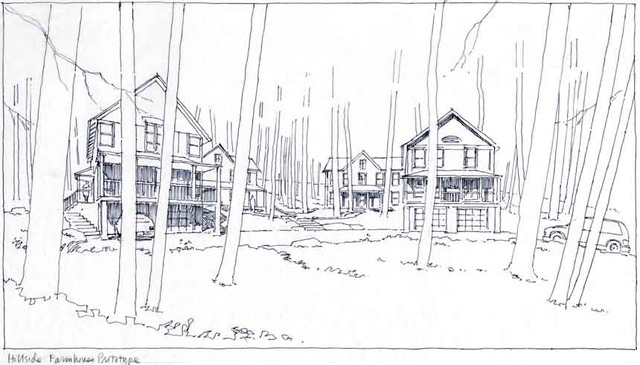
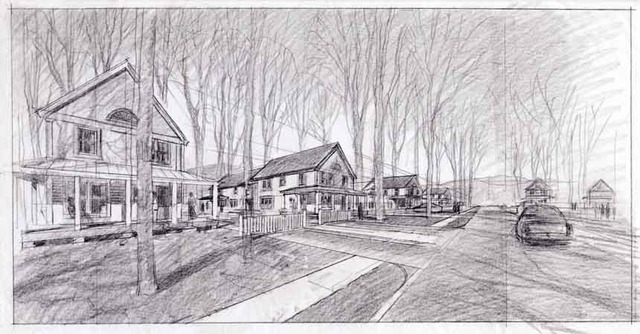
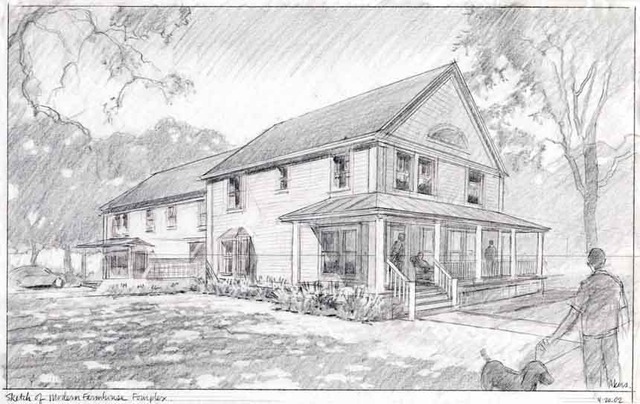


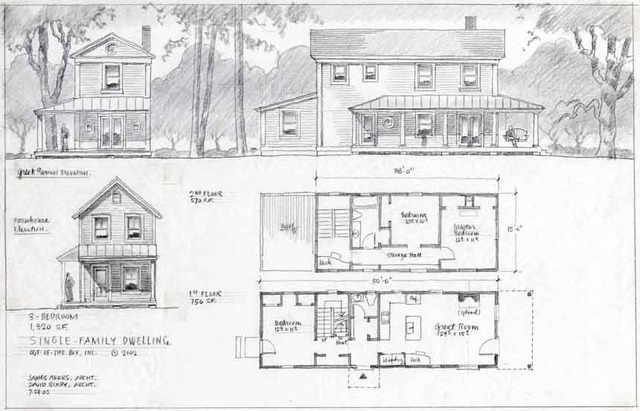
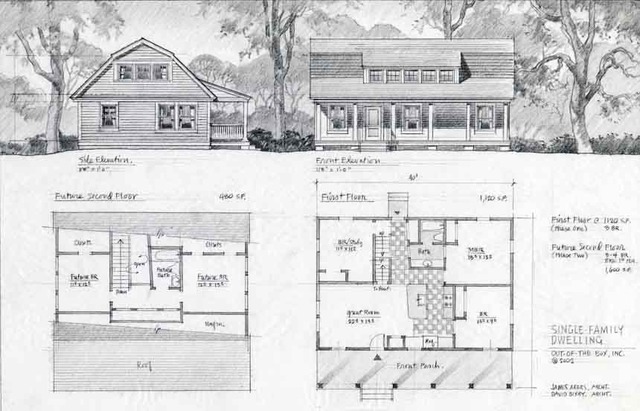
(Note: Welcome to the startup and angel investor community on LinkedIn. Please visit the portfolio portion of this site to see other examples of architectural--building, software or otherwise--visualization techniques.)
Entrepreneurs have a lot on their plates--finding pain points to solve, raising funds, choosing between iPhone, Android, and now iPad platforms, cutting through crowded marketplace noise, etc. Great ideas must elegantly solve pain while being fun to use, hyper-efficient to navigate and joyous to spread. UX (user experience) designers know they're going to lose half of their audience with every click, so making mobile and web apps simple, stunning and "sticky" is job one.
UX design is central to any web 2.0 start up conversation. There are many wireframe programs available to help, but the medium is the message, and these aides tend to make the apps they help create look the same. Why not follow the lead of movie directors and entertainment designers and use storyboards to nucleate your vision, get team members on the same page, and communicate to investors in a striking and company-differentiating way?
Taking the metaphor a bit further, UX design is a lot like set design (see samples included) only your stage is held in the palm of your hand (on your mobile device). Providing examples of storyboarding will be a recurring theme in this blog, beginning with some in-progress and very rough UX sketches for a social mobile start up being developed right here in western Massachusetts. (Yes, western Massachusetts. Afterall, we were home to Bo Peabody and Matt Harris's Tripod, so we can certainly do it again.) These begin as rough pencil sketches made in real-time working with developers around a table, and evolve after many iterations into publishable memes that tell your story. I can't tell you much about the startup idea involved here, but the clever ones among you may figure it out.
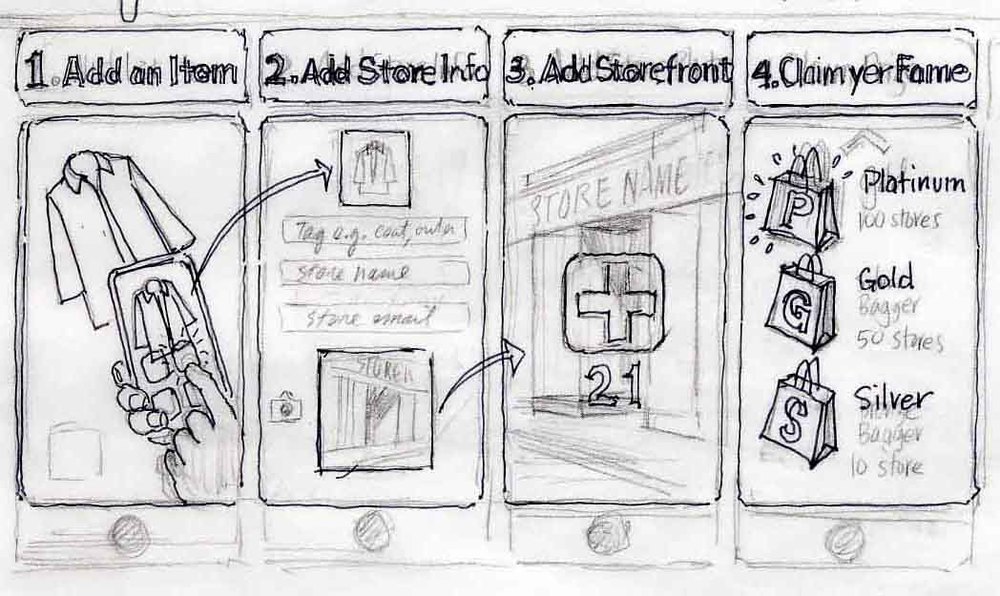
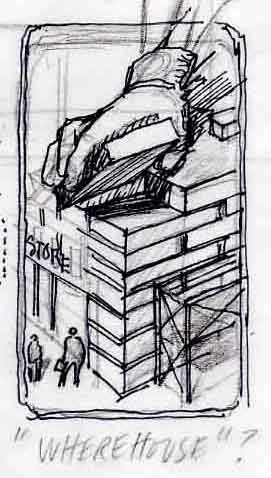
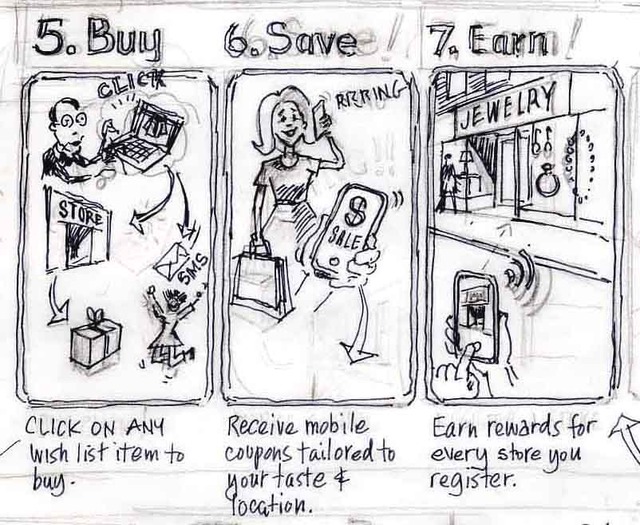
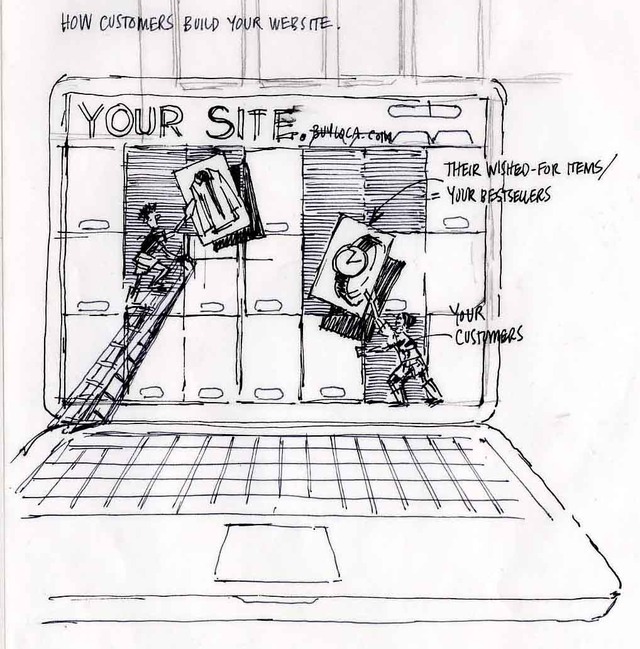
That's it for the UX stuff I can show on this project. Below are a sampling of storyboards made in collaboration with famed set designer/architect David Rockwell, and several other firms doing work in the entertainment industry.

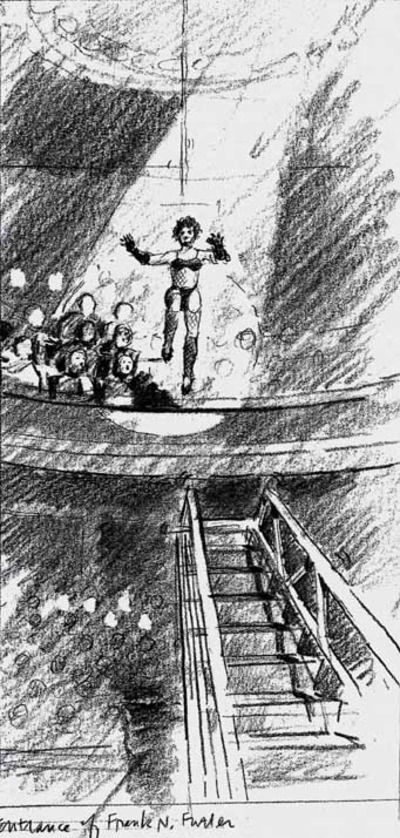
The moment of Frank's Entry in the staged production of Rocky Horror Picture Show.
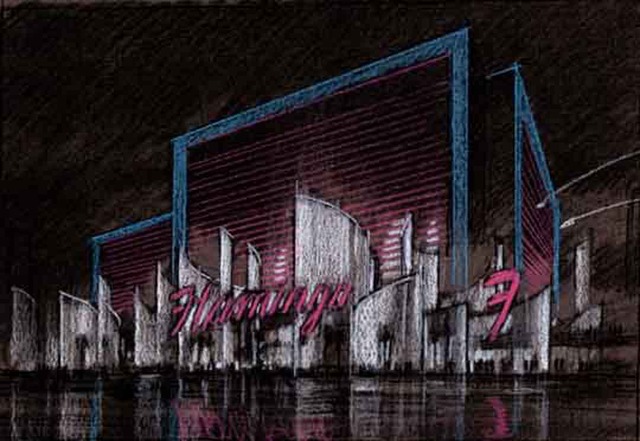
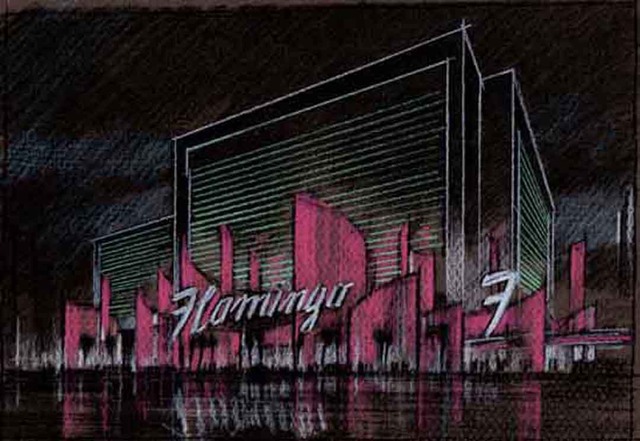
Studies for the "reinvention" of the aging Flamingo Casino in Las Vegas.
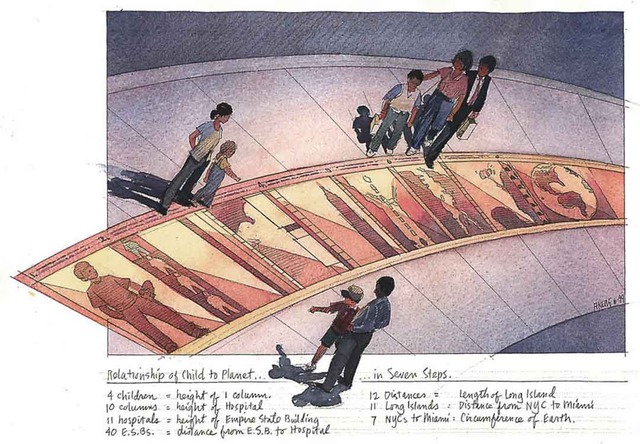
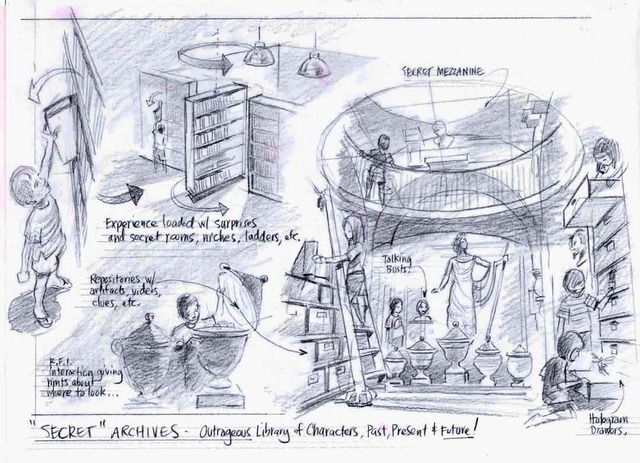

Thanks for coming, and please stay tuned for more on how storyboarding can help your startup (or startups if you're an angel investor) focus team effort and get to launch faster.
Appendix: Here are some keywords which will help readers index this article:
architectural rendering
watercolor techniques
architectural renderings
architectural rendering techniques
watercolor rendering techniques
pen and ink techniques
watercolor rendering
watercolor techniques
architectural sketches
watercolor rendering techniques
watercolor techniques
architectural watercolor rendering techniques
pen techniques
different watercolor techniques in rendering
architectural sketching
pen and ink
sketching techniques
architectural rendering in watercolor
rendering watercolor
In advance of the hot tub rennaissance sure to happen with the release of the art film "Hot Tub Time Machine," I submit the question: why can't one rent a hot tub on wheels? Can somebody get on that please?
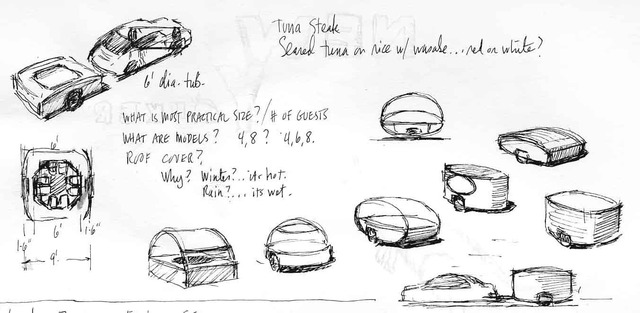
Here's an idea Mary Pat and Spencer had for a line of children's toys based on Olympic Winter and Summer Games. A toy consultant said it was too "Beatrix Potter." (Is that a problem a few iterations wouldn't have solved?) Call me sentimental, but the idea was to reduce the level of "gar-bozh" in the world and get back to something that fostered the imagination. The line was to be placed at POS of ski shops and ski resorts around the world, as option for families looking for alternatives to "more hotel room vacation TV." There's a line for the Summer Olympics, too. As usual, click on any image to make larger.
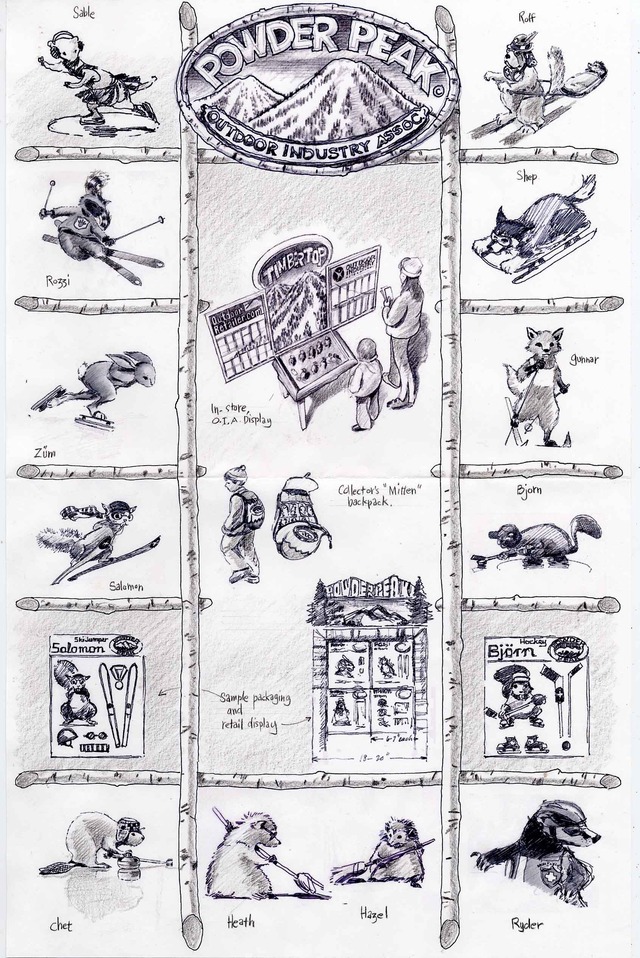
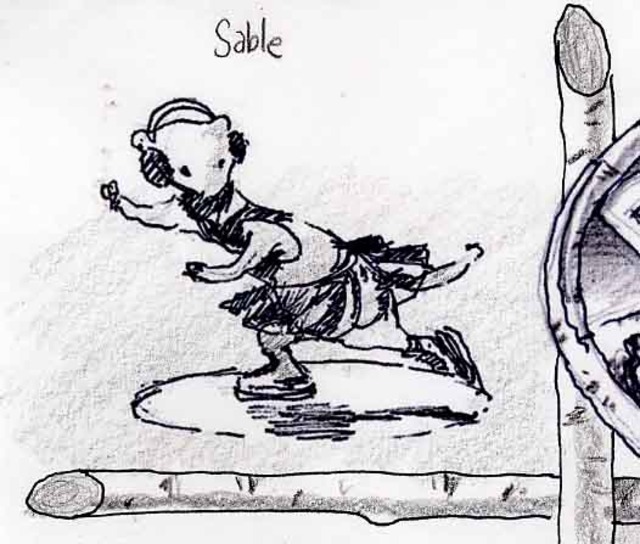
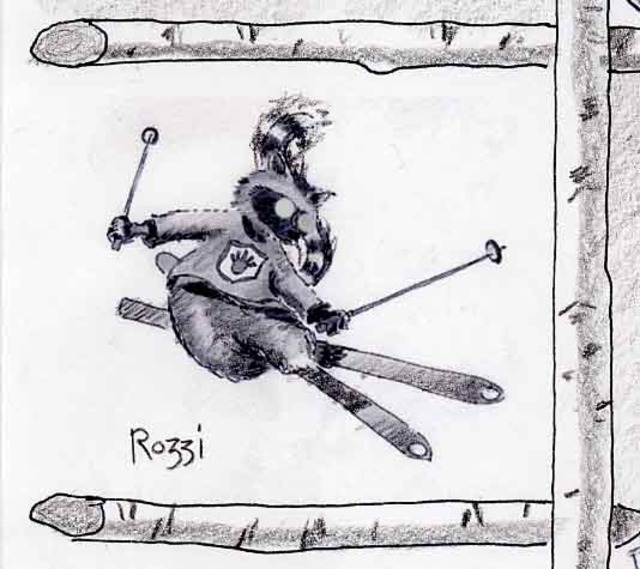
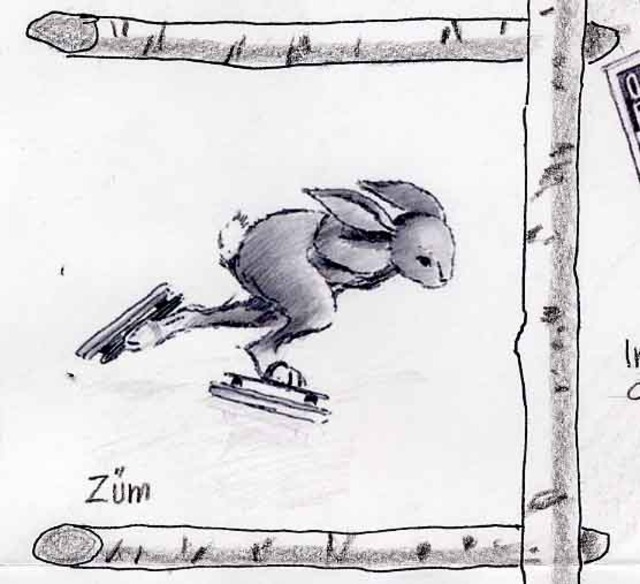
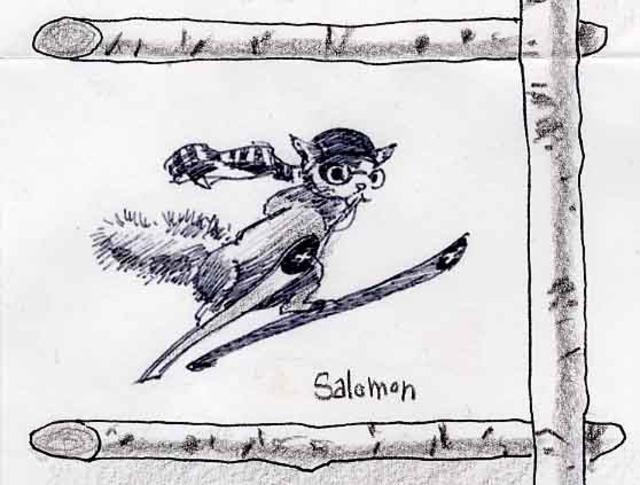

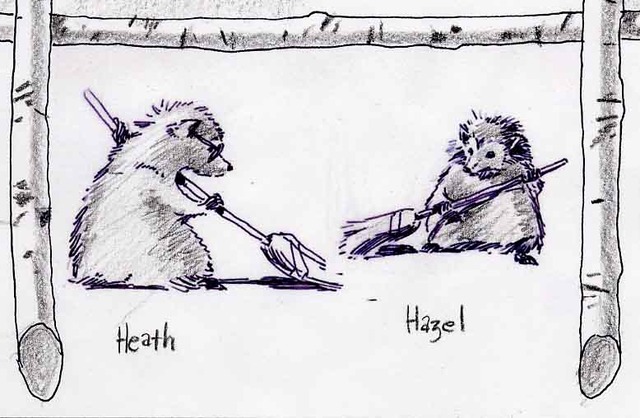



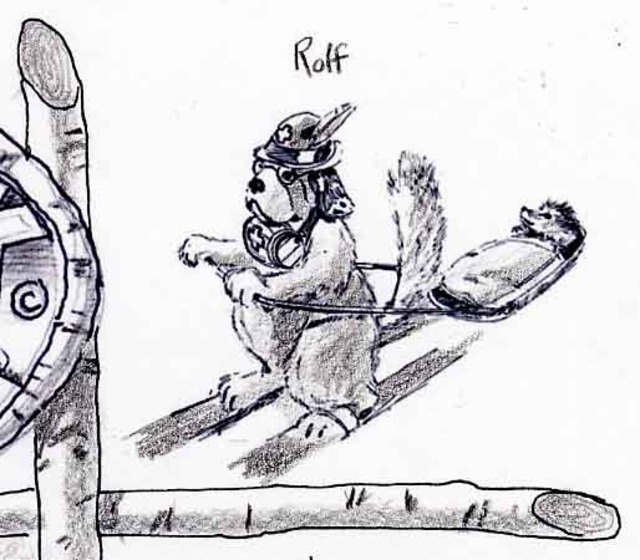
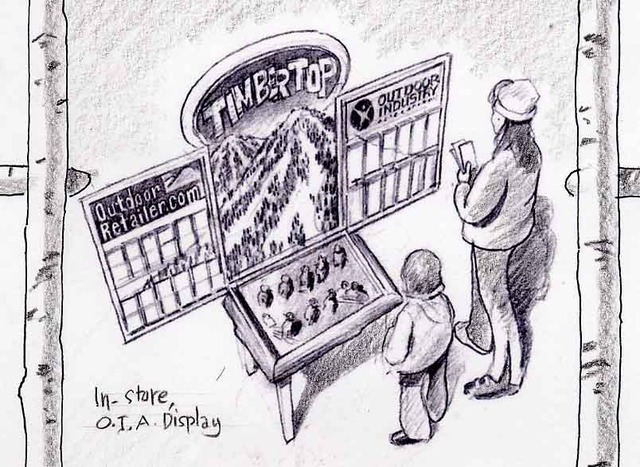
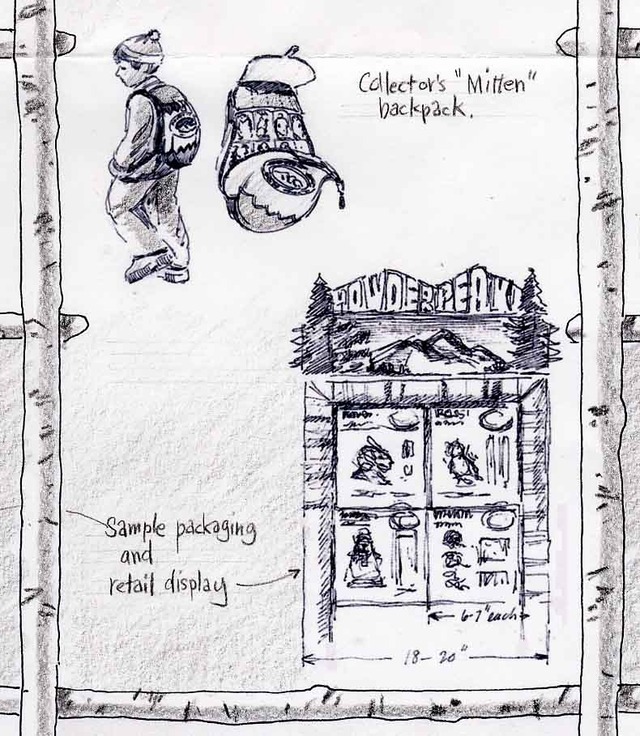
My job can be tedious, but it isn't always a grind (sorry). As every architectural renderer knows, drawing people is more time-consuming than drawing the exterior or interior of a building. People make or break a rendering. When drawn poorly, they tell the world that you (the artist) don't actually know what you're doing, and no amount of watercolor technique can hide that.
Problem is, drawing them well takes time: time to draw the figures in convincing positions; time to dress them; time to "light" them and paint them in a way that Winslow Homer or Sargeant would be proud of. OK, maybe not that last one, but seriously, when you paint in watercolor, your watercolor technique is who you are, and as a thoughtful person putting their work out into the world, you can't pretend you don't know the work of Homer, Sargeant, Prendergast, etc.
Sometimes that investment of time is less tedious than others. For art's sake, I humbly submit "Peep Show," an entertainment/club venue that I was asked to visualize, (populate) and bring alive for a colorful Broadway director turned Las Vegas impresario. (It's like five renderings in one, so I've included vignettes after the overall view. Also: I wish to acknowledge the important contribution of friend and colleague Chad Rush in helping me get this Sistine Chapel of Soft Porn done on time.)
Click on any image to enlarge, er, um...the image.
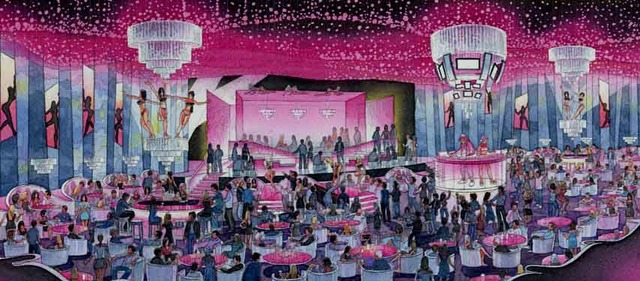
Here's the overall view above. Details of the people below. And yes, those are naked women crawling on top of the glass-sealed VIP lounge on stage:)

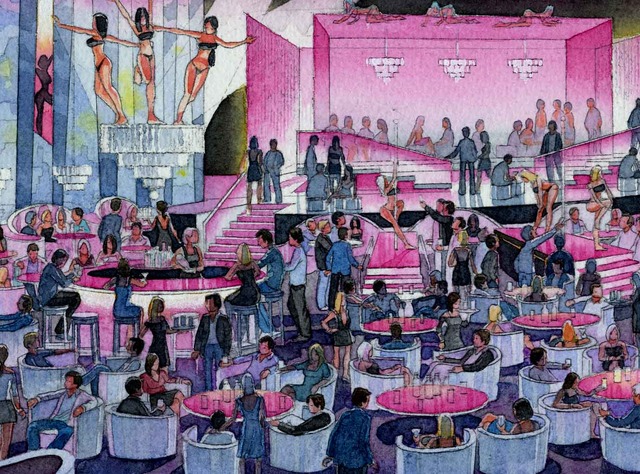
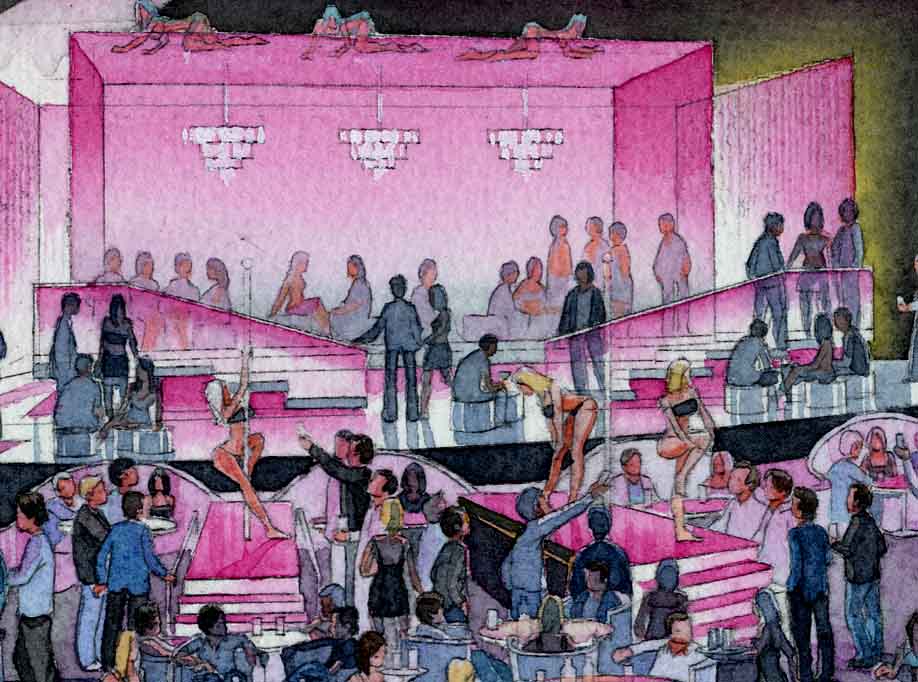
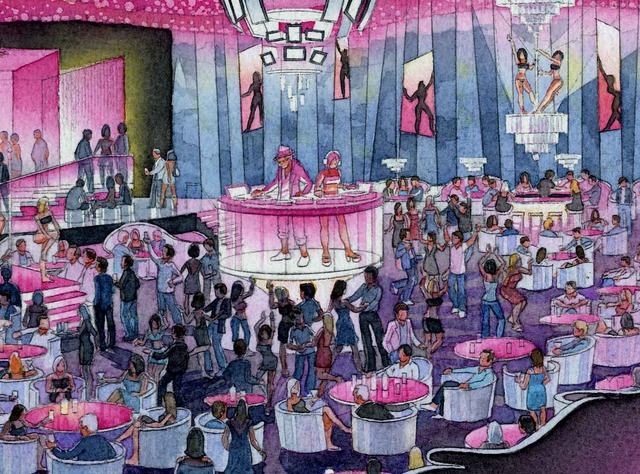
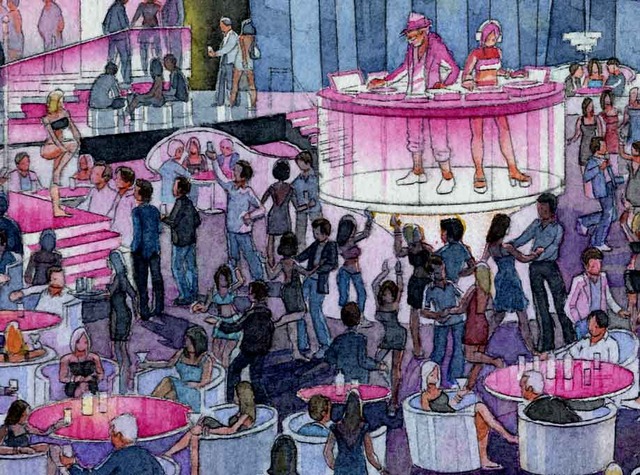
Dining "Half Off." The Magic That Was Almost The David Copperfield Restaurant In Times Square, NY
Many years ago I had the pleasure of collaborating with David Rockwell to design (then do the architectural illustrations and 3D visualizations of) a restaurant prototype for David Copperfield, the famous magician. The concept was part of the genre of destination/tourist entertainment restaurants popular at the time, and this one might have been the most entertaining had it happened. Among the many other delights--levitating tables, waiters disappearing in full view of diners, etc.--was the twice-a-night moment when the maitre d' asked for four volunteers who would like to be, um, sawn in half--I kid you not. The following four views show the design we came up with--heavily influenced by Piranesi's "I Carceri"--for that event,. If you look closely, those of you who know him well will recognize my friend Marty Kapell as one of the people about to dine half off. He's the one in the white sweater vest waving atop the Lady Liberte's hand at the end:)



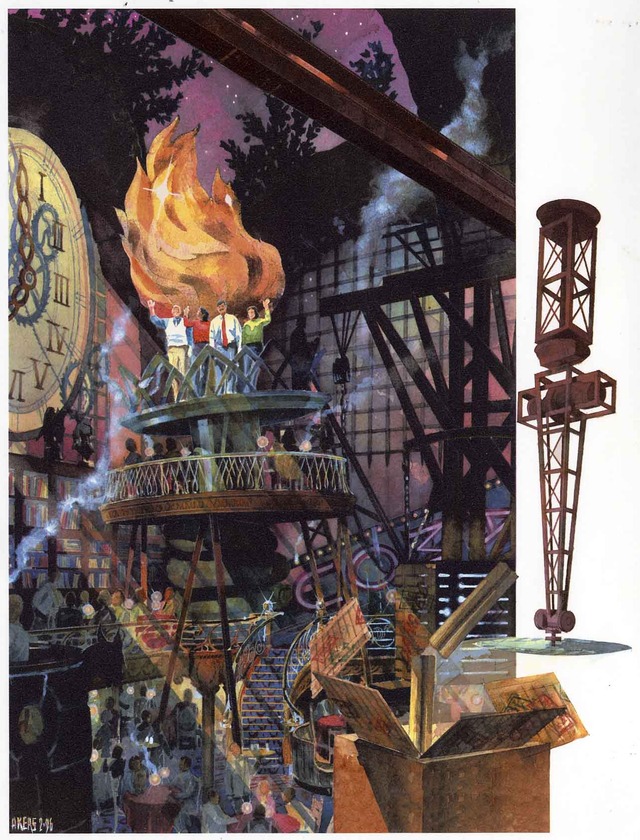
Appendix: Here are some keywords which will help readers index this article:
architectural rendering
watercolor techniques
architectural renderings
architectural rendering techniques
watercolor rendering techniques
pen and ink techniques
watercolor rendering
watercolor techniques
architectural sketches
watercolor rendering techniques
watercolor techniques
architectural watercolor rendering techniques
pen techniques
different watercolor techniques in rendering
architectural sketching
pen and ink
sketching techniques
architectural rendering in watercolor
rendering watercolor
Is it me, or was the set design the star of the 2010 Oscars ceremony last night? I couldn't get over the coordination between the elegance and beauty of the set as a whole, and the way the individual pieces--constantly rotating in and out to deliver presenters and video walls--never overpowered the people on stage. If you have any idea how much work that takes, than you are as amazed as I am at how flawlessly coordinated were the sets, the people, the production and the camera angles designed to take advantage of it all. It really was a tour de force.
I can't take any credit for helping with last night's design beyond the work we did last year (see below) when David Rockwell first did the design, and the contribution of some early sketches this year used to establish a rough direction, but a number of people behind the scenes do deseve credit beyond what the public is normally aware of. I don't think it's taking anything away from David Rockwell to say that my friend Barry Richards--David's number one collaborator on sets, and design director of one of David's coolest studios (also doing restaurants, high-end apartments, etc.)--was instrumental in realizing last night's miracle. Here are some sketches for the Oscars and for Broadway musicals that David and Barry have asked me to do over the years. Again, congratulations to both and to Rockwellgroup in general for what I truly believe was a masterpiece of set design and set movement.

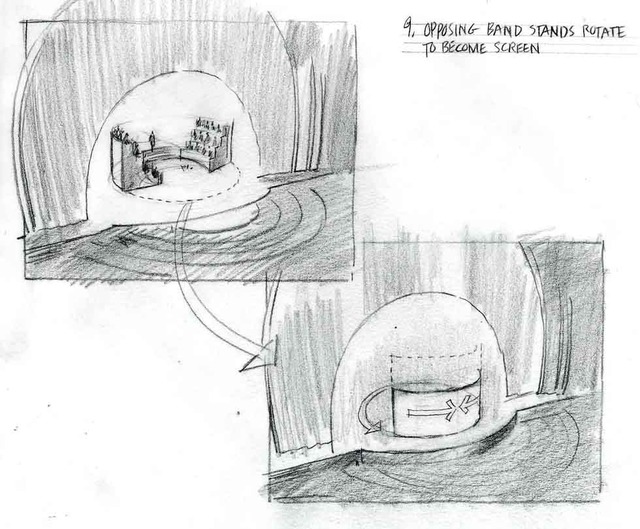
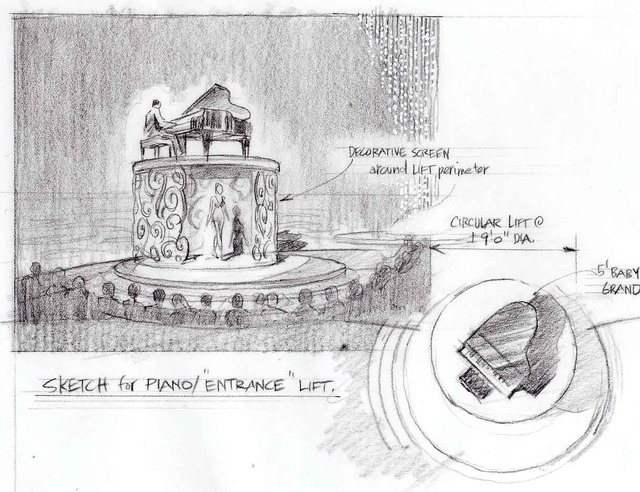

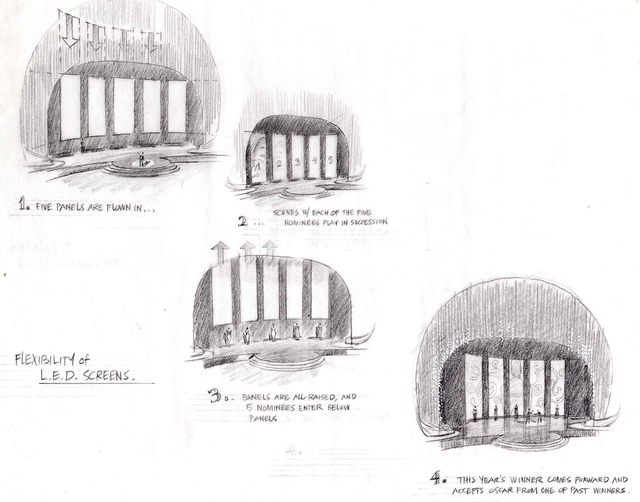
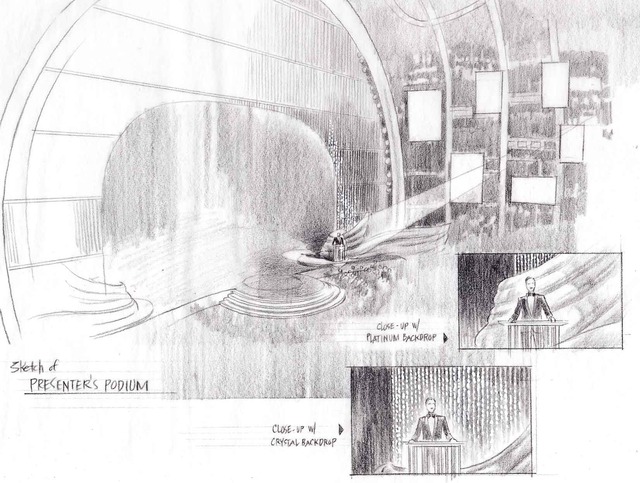

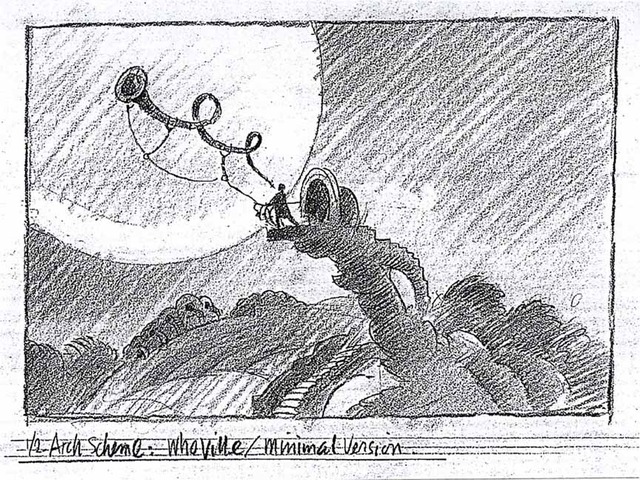
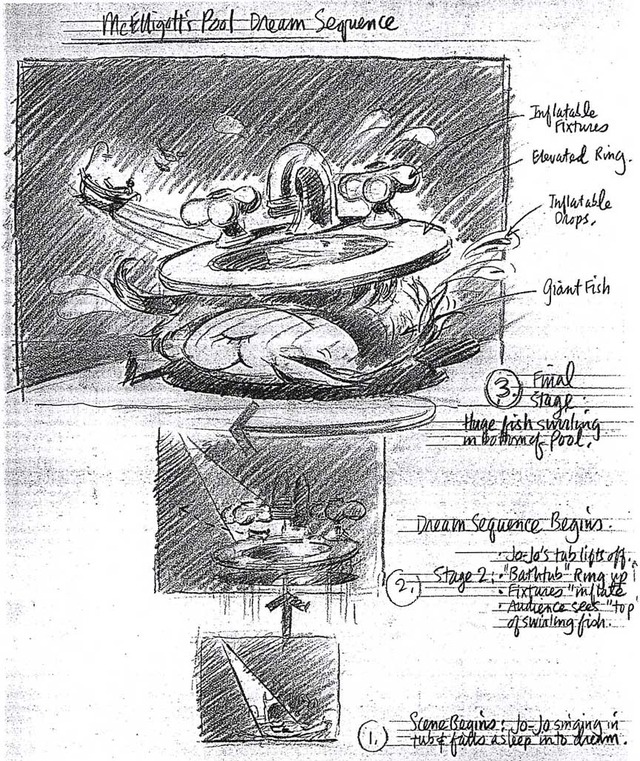
When you grow up wanting to be an architect, you learn about the Chapel at Ronchamp at an early age. It's an icon of modern design, as interpreted by the early 20th century architect Le Corbusier. Corbu and Frank Lloyd Wright were a little bit like Madonna: artists so rich in ideas (Madonna? OK, maybe I went too far, but you get the point) that they were capable of remaining ahead of trends they themselves ironically created, reinventing themselves and opening up new veins of ideas in their art several times over their careers.
Ronchamp represents a late stage in Corbu's career when, like many poets, he began to see beauty in traditions and forms he might have held in contempt during his revolutionary youth. The building is based on a traditional plan, but it's striking forms are pure modern invention, some say based on a nun's hat.
We went to see the place at the end of a trip to visit Spence in Leysin, Switzerland, during his junior year of high school at the American School of Leysin. I walked around taking these exterior photos, then went inside.
Given the expectations set by the exterior, one is kind of shocked by the intimacy of the interior. One discovers the acoustics are insane. One gets the uncontrollable urge to do a Gregorian chant.
Did any of you have a memorable experience visiting Ronchamp? I'm hoping none of you say "Yeh, one time I was there and this douchebag was singing inside."
Even though I make my living doing architectural watercolor renderings, and architectural rendering, watercolor techniques, pen and ink techniques, watercolor rendering techniques and architectural rendering techniques, I still want to go back to doing architectural design someday. There's nothing like the feeling of creating a building.
One of the worst myths ever perpetrated on high school kids contemplating careers in architecture is that architects have to draw well and be good at math. In 30 years of being an architect, I have yet to see a single architect "need" to know any math beyond simple geometry, and yet the profession as a whole has probably lost tens of thousands of talented kids (especially girls) because of this lazy meme propagated by well-meaning guidance counselors. (Btw, please call me if your kids are thinking about architecture. I genuinely enjoy discussing the pros and cons of being one, especially exploding these myths.)
The same goes for drawing. Yes, architects are supposed to draw well, and many of the greats have always done so, but some of the greatest use nothing more than scribbles to communicate their ideas to workshops of apprentices (think Frank Gehry, Louis Kahn...) and this is as it should be. Why? Because over-drawing--drawing too realistically or too sentimentally--discourages the accidental discoveries vital to the design process and miraculously present in the final work of art. I say "miraculous" because it is nothing short of miraculous when an architect--or painter, or musician, or sculptor--spends hundreds of hours on a work which manages to transcend both its materials and the tedious steps involved in making it. Said another way, there is a kind of magic in every work of art: it's usually impossible to look at it and understand how it was done.
Here is a house I am designing for a best friend who is moving to Big Sur, Caifornia. The site is on the water, and when you're there, all you are conscious of is the sun on your skin, the warmth you feel when the chilly wind stops blowing, and the sound of the Pacific at the western edge of the property.
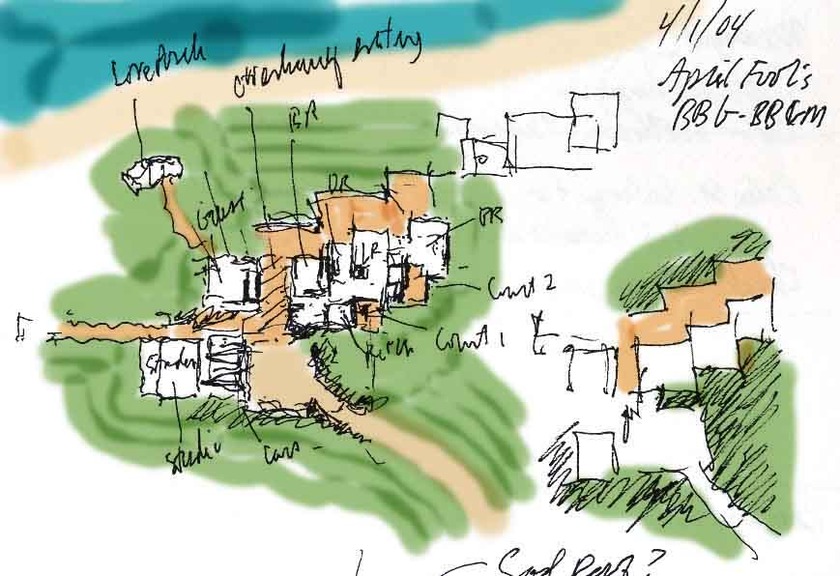
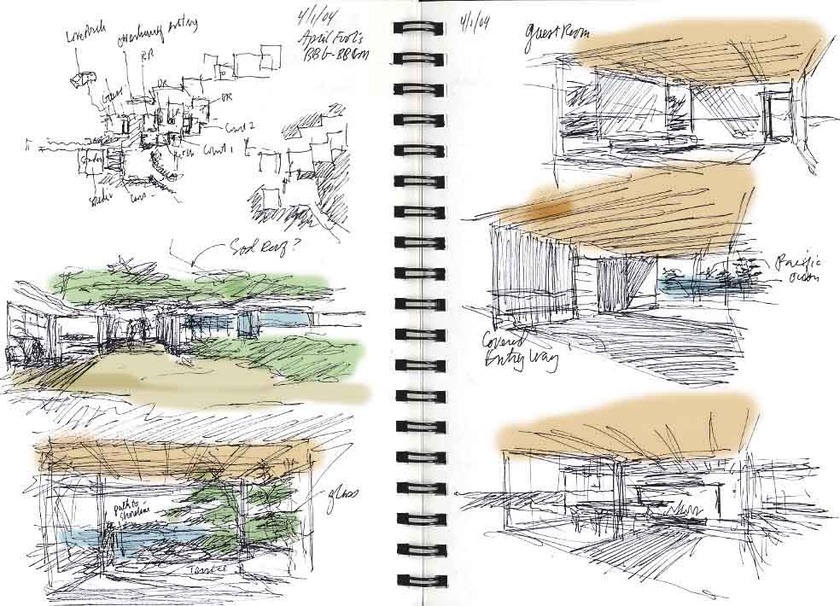
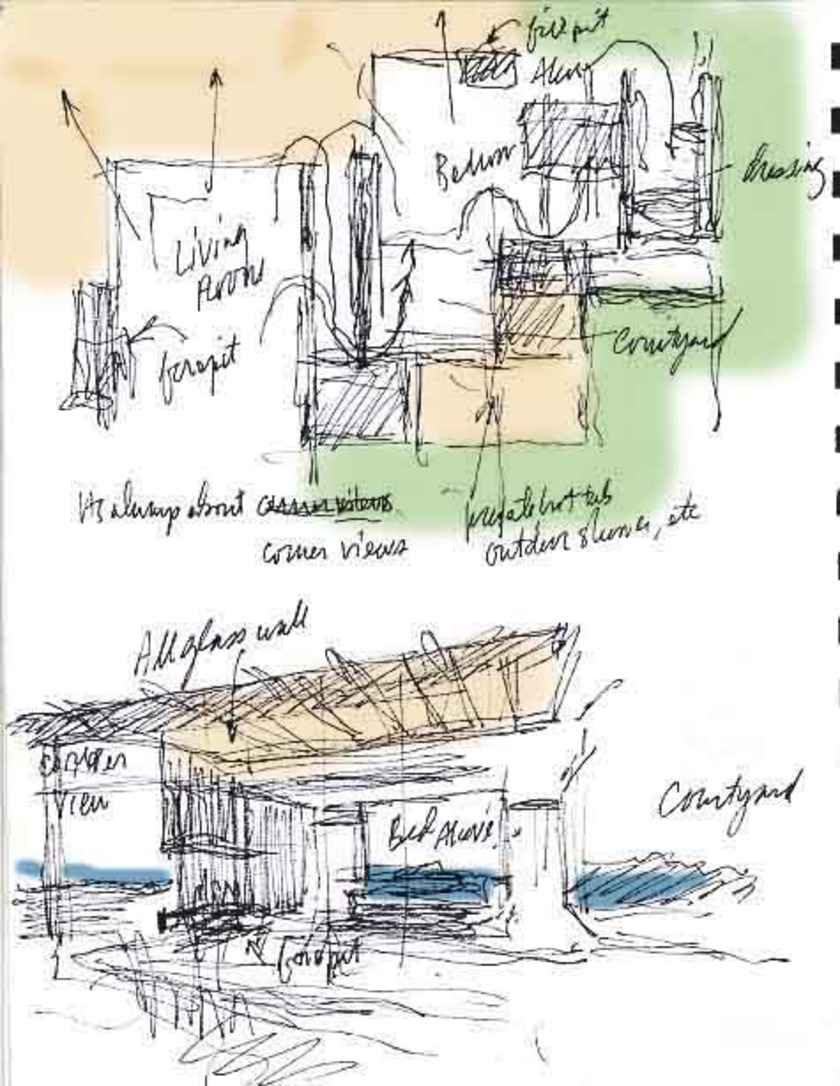
So why do these design sketches look so "bad" (considering I'm a "renderer")? Because it's not about making pretty drawings at this stage; it's about maximizing the chances that your pen will slip and lead you to a bunch of accidental discoveries that defy logic and keep the end product magic. Realistic drawing skills and math only get in the way of the process. Does an aptitude for drawing and math help? Yes, but not beyond a 7th or 8th grade level, at best.
Attend our free Procreate Weekend Workshop to see all the ways digital drawing can make you a better designer, and help you rediscover the benefits of drawing by hand in the Digital Age.